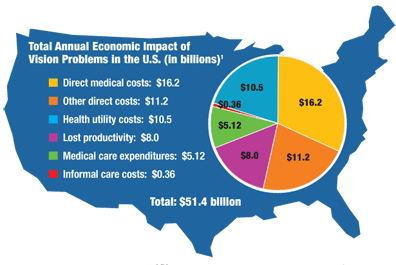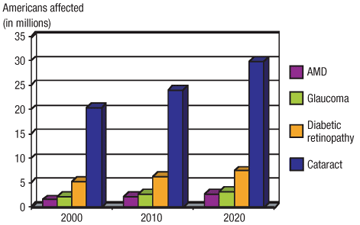
You cant put a dollar amount on good vision. It is truly priceless. On the other hand, bad vision has been estimated in dollars. A lot of dollars. In the United States, the total price tag for vision problems is astronomical: $51.4 billion in one year, according to a report from Prevent Blindness America.1 (Or even as high as $67.6 billion a year, according the National Eye Institute, which used different estimates.2)
That amount is difficult to comprehend. Think of it this way: With $51.4 billion, you could buy the Empire State Building 1,000 times over and still have change. Or, you could buy half a million Maserati luxury sports cars. Or, buy more than 200 million iPods. Or, eat 14,685,714,286 Big Macs.
In other words, the annual economic burden of vision disorders is just enormous. And, its only going to get costlier as the number of people with vision problems grows. Currently, more than 38 million Americans age 40 and older are blind, visually impaired or have an age-related eye disease, such as age-related macular degeneration, glaucoma, diabetic retinopathy or cataracts, according to the National Eye Institute. As life expectancy increases and medicine improves, this number is expected to grow to more than 50 million Americans by the year 2020, with a correspondingor even acceleratedincrease in eye care expenditures.
But, the future is unwritten. Thats why its important to look at these costs and understand them. Advocates are now using these numbers to try to affect policy in order to increase funding and efforts aimed at prevention. The goals: to mitigate and reduce vision problems (especially correctable ones), and to keep in check the cost of vision problems on the
Inside the Numbers
Whats included in these numbers? The $51.4 billion total comes from the addition of two different sums from separate analyses. These include:
$35.4 billion in direct medical costs, other direct costs and lost productivity.3 This figure reflects the costs of treating major vision disordersvisual impairment, blindness, refractive error, AMD, cataract, diabetic retinopathy and primary open-angle glaucomain Americans past age 40. (See Direct Medical Costs by Disorder.)
Direct Medical Costs by Disorder Condition
Total direct medical costs plus nursing home costs equaled about 1.5% of all U.S. health-care spending in 2004 (which was $1.86 trillion), says lead author David Rein, Ph.D., of the research firm RTI International.
Direct annual medical costs for outpatient, inpatient and
Cost (in billions)
Percentage of total direct medical costs
Cataract
$6.80
41.9%
Refractive error
$5.51
33.9%
Glaucoma
$2.86
17.6%
AMD
$0.57
3.5%
Diabetic retinopathy
$0.49
3.0%
Total
$16.24
100.0%
$16 billion in medical care expenditures, informal care costs, and loss in value of quality of life.4 Visual impairment per individual (compared to no visual impairment) is associated with more than $1,000 of additional medical expenditures annually. Likewise, blindness is associated with more than $2,100 of additional medical expenditures. The negative impact on quality of life is about 50% greater for blindness than it is for visual impairment.
For simplicitys sake, this research does not take into account other common ocular conditionssuch as conjunctivitis, strabismus, trauma and uveitisthat would likely raise the overall direct medical cost by 15%. In addition, researchers conducted this analysis in 2004, before the expansion of Medicare Part D, which made drugs more available to Medicare beneficiaries by subsidizing the costs of prescriptions. This was also before the more widespread usage of anti-VEGF drugs, which means that the direct medical cost for AMD is now probably higher.
More money is spent on the direct medical costs of eye care ($16.2 billion in 2004) than on the direct medical costs of many other significant diseases, such as HIV ($9.4 billion), breast cancer ($7.2 billion) or asthma ($5.3 billion), Dr. Rein notes. He cautions that these numbers can be tricky to compare, since theyre compiled by different methods.
Costs Are Rising
Eye-care costsalong with all health-care costsare not just expected to grow, but to grow more rapidly. This goes hand-in-hand with the rising numbers of visual disorders. (See Visual Impairments in the Year 2020.) Few numbers are available to predict future eye-care costs, but consider the escalating cost of all health-care expenditures: Visual Impairments in the Year 2020 People 80 years of age and older currently make up 8% of the Other estimates of vision impairment for the year 2020: Condition Source: Eye Diseases Prevalence Research Group. Causes and prevalence of visual impairment among adults in the

Likewise, the numbers of people who are blind or have low vision will increase substantially. Blindness or low vision now affects 3.3 million Americans age 40 and older. This figure is projected to reach 5.5 million by the year 2020, according to the Eye Diseases Prevalence Research Group.
Population in 2004
Population in 2020
AMD
1.75 million
2.95 million
Cataract
20.5 million
30.1 million
Diabetic retinopathy
4.1 million
7.2 million
Glaucoma
2.22 million
3.36 million
Spending on health care has risen about 2.4 percentage points faster than the
In 1970, the
In 2007, health-care spending is projected to be more than $2.2 trillion, or just under $7,500 per resident, and account for 16.2% of GDP.
By 2016, health-care spending will be more than $4.1 trillion, or $12,782 per resident, and account for 19.6% of GDP.
By 2025, health-care spending will be 25% of GDP. Thereafter, health-care costs will continue to account for a steadily growing share of GDP, reaching 37% in 2050, and almost half (49%) of GDP by 2082.
Age-related eye diseases are projected to rise 65% by the year 2020, largely due to the longer life expectancy of baby boomers.1 But, will there be enough optometrists and ophthalmologists to handle the additional patient demand? People will live longer, increasing the need for treatments for age-related eye disease. For example, the number of surgical procedures for cataract is estimated to increase nearly 50% by 2020.2 1. Congdon N, OColmain B, Klaver CC, et al. Eye Diseases Prevalence Research Group. Causes and prevalence of visual impairment among adults in the
What Can Be Done?
Eye Doctors in Short Supply by 2020

A shortage of eye doctors seems very likely within the next two decades, although a number of factors will affect the supply and demand of eye-care services.2
Absent major demographic changes, insurance coverage or health financing changes that affect demand for care, or cures for major diseases, there will likely be a substantial amount of work for all eye-care providers in 2020, wrote ophthalmologists Paul Lee, H. Dunbar Hoskins and David W. Parke in an article last year.2
Some of the factors involved:
Epidemics of diabetes and obesity, if left unchecked, will affect an even greater number of Americans in the coming decades. Currently, one in five adult Americans have diabetes.
New advancements in medical technology and pharmaceuticals will increase the number of procedures and treatments. These developments may improve access to care, which would boost the numbers of treatments even higher.
The number of ophthalmology residency positions (about 460 per year) has been holding steady and is not likely to expand in the coming years.
The number of optometrists that graduate each year (about 1,125) has also remained unchanged. However, at least two new optometry schools are expected to begin graduating students by 2010.
Currently, about half of all ophthalmology residents and nearly two-thirds of optometry students are women. Female doctors average 15% fewer work hours than their male counterparts over the course of their careers.2
Another factor that could lessen the demand for eye-care services is the primary prevention of disease, says James Tielsch, M.H.S., Ph.D., who spoke at the
New treatments are leading to an increase in services, Dr. Tielsch says. Yet, disease preventionfor diabetes, for examplelags far behind. We have a complete failure in the primary prevention of diabetes, he says. For instance, the number of Americans age 40 and older with diabetic retinopathy is expected to jump from 4.1 million now to 7.2 million by 2020.1
The train is headed straight for us, Dr. Tielsch says. With the projected increases in visual diseases and disorders, satisfying the demand for eye-care services will be a challenge. Current eye-care manpower projections suggest the workforce will be inadequate by 2015.
Can anything be done to contain eye-care costs? Should anything be done?
Individuals dont think about blindness or vision loss until it impacts them personally. Once it does, its one of the most devastating conditions that theyll ever face, says Jeff Todd, senior vice president of programs and public health at Prevent Blindness America. And, just like individual members of the public, policy makers also really need to be convinced that we need to do something to prevent these conditions.
Policy makers on Capitol Hill and in state capitals are more likely to sit up and take notice when they hear the $51.4 billion price tag and the prevalence of vision problems, Mr. Todd says. It opens their eyes and tells them we should do somethingif not just for the sake of the health care of the American public, we need to do this for our economic health as well.
More funding needs to go toward research and treatment, he says, but prevention is key to control costs to both the
Eye- and vision-care costs are much greater when problems are allowed to progress to an advanced stage, says R. Norman Bailey, M.A., O.D., M.B.A., M.P.H., professor at the University of Houston College of Optometry. Long-term costs should be greatly reduced by providing prevention measures or interventions in the early stages of a developing eye or vision problem.
Prevention measuresas well as education efforts and improvements in accesscan go a long way to address many undertreated or unidentified eye problems. Many of these problems are prevalent, but they can be readily corrected or prevented.
Many members of the public just do not know of the importance of regular examinations to screen for developing eye and vision problems before they become symptomatic, Dr. Bailey says. There is a tremendous need for eye and vision health education programs to inform individuals of the importance of periodic care.
Individual O.D.s can be the catalyst in providing eye health education to their communities, he says.
Dr. Rein says, We know that vitamin prophylaxis for AMD is a cost-effective intervention that provides health benefit at a reasonable cost. Still, the utilization rate at the correct dosage of these vitamins is very low. We also know that early detection of illnesses like glaucoma or frequent eye exams for people with diabetic retinopathy can improve visual outcomes at reasonable costs.
Consider that 25% to 54% of American adults age 40 and older have uncorrected refractive error.5 An alarming number of Americans suffer from visual impairment that could be easily corrected with a simple and cheap pair of properly prescribed glasses, Dr. Rein says.
1. Richman EA. The Economic Impact of Vision Problems.
2. Ellwein LB. Statistics and DataUpdating the Hu 1981 Estimates of the Economic Costs of Visual Disorders and Disabilities. National Eye Institute Web site, 2004 Mar 23. Available at: www.nei.nih.gov/eyedata/hu_estimates.asp (Accessed December 28, 2007).
3. Rein DB, Zhang P, Wirth KE, et al. The economic burden of major adult visual disorders in the
4. Frick KD, Gower EW, Kempen JH, Wolff JL. Economic impact of visual impairment and blindness in the
5. Coleman AL, Yu F, Keeler E, Mangione CM. Treatment of uncorrected refractive error improves vision-specific quality of life. J Am Geriatr Soc 2006 Jun;54(6):883-90.

